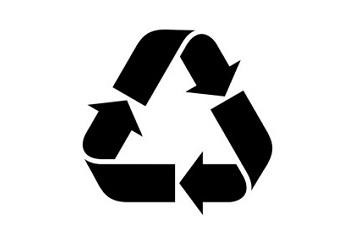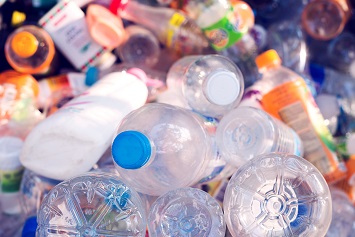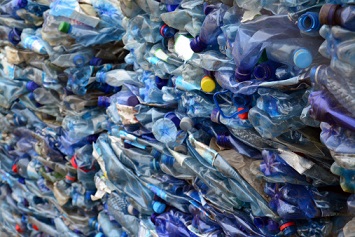More than 2 years after China instituted its National Sword policy, which banned the import of most forms of plastic waste for recycling, the United States has yet to implement environmentally friendly approaches to managing these materials.
Worldwide and in the United States, plastic is being manufactured in record numbers. According to the EPA, in 2017, the United States produced 35.4 million tons of plastic, the largest total to date. The same year, municipal solid waste (MSW) landfills received about 26.8 million tons of plastic waste, or 77% of all plastic produced and 19.2% of all solid waste landfilled. Another 15% of plastic was combusted for energy recovery. Only 8.5% of plastic was recycled in 2017. (Rates vary for different types of plastic, with polyethylene terephthalate (PET), which is used to make beverage bottles, the most recycled at about 18.5%.) Compare this to the recycling rates for cardboard and paper (66%) and metals (33%).
For years, most plastic recycling occurred in China, which—since 1992—imported 45% of the world’s plastic waste. In 2015, U.S. exports of waste plastic comprised about 6% of total domestically produced plastic. But in January 2018, China introduced a policy that banned the import of 24 types of recyclable materials, including common plastics such as PET, polyethylene (PE), polystyrene (PVC), and polyvinyl chloride (PS). In addition, China set higher purity standards for the plastics it did import. Many types of plastics are manufactured with colorants and other additives, including toxic ingredients, that basically eliminate the recycling option. There has been some transfer of U.S. plastic exports to other nations, primarily in Southeast Asia, but there is concern that much of that plastic is not managed in an environmentally responsible way. Also, these nations are nearing their capacity to accept imports.
Ocean Pollution
Perhaps the most troublesome consequence of the global mismanagement of plastic waste is that a great deal of this material is finding its way into the oceans. Jenna R. Jambeck, an environmental engineer at the University of Georgia, who specializes in solid waste and marine debris issues, testified at a March 2, 2020, hearing of the House Subcommittee on Environment and Climate Change that research conducted in 2010 found that the annual input of plastic to the world’s oceans is equal to five grocery-sized bags filled with plastic along every foot of coastline in the world. Under a business-as-usual scenario, Jambeck projects that this number will double by 2025.
Life-cycle analyses also show that plastic contributes to climate change. Petroleum is one component of plastic, and petroleum production generates greenhouse gases (GHGs). Also, plastic that breaks down in the oceans may interfere with the ocean’s capacity to absorb and sequester carbon dioxide. Incinerated plastic in waste-to-energy processes is, globally, another major contributor to climate change. The House hearing memo notes a May 2019 report by the Center for International Environmental Law, which states, “In 2019, the production and incineration of plastic will produce more than 850 million metric tons of greenhouse gases—equal to the emissions from 189 five-hundred-megawatt coal power plants.”

Local Recycling Plummets
In its memo, the House Subcommittee noted some of the major challenges the United States is facing because of China’s policy. The memo states:
“While China’s policy shift presents certain new challenges, it also exposed longstanding issues in the U.S. recycling system. The ability to export vast quantities of waste made recycling simple and profitable, but slowed the development of U.S. markets and infrastructure for recovered waste. It similarly allowed consumers to focus on management of their waste, rather than reducing generation of waste in the first place.
“In the United States, the growing imbalance between supply and demand for recovered waste has caused the value of recyclable material to plummet. Municipalities—including small and rural towns, in particular—have been hit hardest by the market downturn. Until recently, local governments were typically paid to sell their recyclable waste to processors who, in turn, sold that waste to Chinese importers. Those processors, now lacking buyers, must recover lost profits by charging more to municipal customers.
“As a result, many municipalities have scaled back their recycling programs. Some have reduced the types of items they will accept for recycling, while others have canceled their recycling programs altogether. Many local governments are now paying to transport their recovered waste to landfills, or simply instructing households to put certain types of otherwise recyclable materials in the trash.”
Part of the problem is that, per person, the United States generates two to six times the amount of waste of many countries. This also suggests that recycling, at least as it is now conducted, is not the answer to plastic waste. For example, the memo notes that approximately 80% of U.S. recycling programs use single-stream recycling, in which all materials—glass, paper, plastic, and aluminum—are collected together, rather than sorted.
“This approach simplifies recycling for both consumers and waste collectors, but presents challenges for waste-sorting facilities,” states the memo. “When combined in a single stream, the various materials mix, break, and contaminate one another; moreover, consumers often inadvertently include unrecyclable (or even hazardous) materials in their recycling. These contaminated waste streams clog processing equipment, lower the value of potentially profitable materials with which they are comingled, and, in some cases, render the entire stream unrecyclable. By one estimate, about one-quarter of the waste in recycling bins is too contaminated and must instead be sent to landfills.”
Policy Solutions
According to the House memo, public policy can play a central role in reducing waste and improving the U.S. recycling system. Potential policy mechanisms include:
- Extended producer responsibility, which shifts the cost of managing post-consumer waste away from municipalities and onto producers;
- Container deposit programs, in which a small fee for packaging is levied at the point of purchase and refunded to the consumer upon return of the original material;
- Post-consumer recycled content requirements, which require a minimum amount of recycled material in specified products;
- Fees or taxes on single-use items or certain materials;
- Bans or restrictions on single-use items or certain materials;
- Infrastructure investments to improve waste sorting and processing; and
- Improved labeling and education to clarify recycling rules.
High-Value Materials
Jambeck and other witnesses at the hearing expanded on these approaches and offered others, as well as different perspectives on the general issue of waste plastics. The following comments from their testimony illustrate their views:
“Being thoughtful about the materials we use and the design of our products and packing are essential to increasing capture and recycling rates. If a material itself is not of high enough value to promote recapture, then a deposit-return scheme may be needed to incentivize collection (deposit-return schemes in place in the U.S. show a 40% reduction in litter from beverage containers).
“Product stewardship/extended responsibility initiatives can do several positive things like provide resources for the collection and management of waste (primarily the responsibility of communities and citizens right now), incentivize more consistent design of packaging and material usage to retain value, and stimulate the economy with more domestic recycling business opportunities.
“If high value materials are used, and domestic markets are developed, the export of recyclables will not be as necessary and can be reduced. In addition, if export is needed, then the materials will be cleaner and of higher value as a commodity to others promoting positive global trade (especially if the U.S. helps countries develop context-sensitive solid waste management systems globally).
–Jenna R. Jambeck, Distinguished Professor in Environmental Engineering, University of Georgia
Cost of Alternatives
“The plastics industry continues to move towards a more circular economy for plastics. In 2018, America’s plastic makers established a goal of making all plastic packaging in the United States reusable, recyclable, or recoverable by 2030 and for all plastic packaging to be reused, recycled, or recovered by 2040.
“China’s National Sword policy that restricted imports has resulted in serious disruptions to recycling programs in the U.S. and around the world. This disruption, while costly over the last year and a half, has created an unquestionable opportunity for U.S. investment. Over the last 18 months, we have seen more than $4.2 billion in new investments in plastics recycling with potential to divert 6 billion pounds of plastics from landfill.
“Focusing on plastic product bans without consideration of the availability and environmental impacts of alternatives is counterproductive. Studies by Trucost and Franklin & Associates show that alternatives to plastics have greater environmental impacts such as greater energy use, increased greenhouse gas emissions and more waste. In the 2016 report, the environmental accounting firm Trucost found the natural capital cost of plastic in 16 sectors to be $139 billion but the environmental costs for alternative materials was estimated at $533 billion annually. This 3.8-fold increase in natural capital costs of alternatives included greenhouse gas emissions, marine litter, and other impacts. In a study of plastic packaging compared to alternatives, Franklin Associates found that greenhouse gas emissions would be doubled by banning plastic packaging.”
–Keith Christman, Managing Director, Plastic Markets, American Chemistry Council (ACC)
PET Bottles
“We need to start with the low hanging fruit—materials that are currently authentically recyclable, in high demand, and being lost by the millions of tons to landfills and incinerators. For example, #1 PET bottles (mostly water and soda bottles) are highly recyclable and, in theory, in great demand. More and more brands are recently making public commitments to use more recycled bottles to make their new bottles, which currently only use an average of 2% recycled content. Yet right now, only one in ten PET bottles are recycled, and prices for PET on the market remain far too low, because we are competing with cheap, heavily-subsidized virgin ethylene derived from fracking and other extraction. Policies like recycled content mandates and thoughtfully designed container deposit legislation, as well as investments in education, collection and processing have proven to be able to get many more bottles out of the trash and displace the need for virgin petroleum.”
–Lynn Hoffman, Copresident & CEO, Eureka Recycling
Ban Single-Use Plastics
“Ban the production of single use plastics and plastics that cannot be mechanically recycled and enact a national container deposit program to promote recycling markets. If at the end of a material’s life, it cannot be mechanically recycled or composted, and there are no sustainable, reliable, affordable, and safe means of disposing of them—currently there is not—it should not be produced in the first place.”
–Denise Patel, U.S. Program Director, Global Alliance for Incinerator Alternatives
Bills in Congress
There are at least two bills in Congress intended to reduce the disposal of waste plastic:
- The Realizing the Economic Opportunities and Values of Expanding Recycling (RECOVER) Act (H.R. 5115) would allocate $500 million in matching federal grants to eligible states, local municipalities, and tribal governments to invest in improving their recycling infrastructure, programs, and education efforts. H.R. 5115 has industry support.
- The Break Free From Plastic Pollution Act of 2020 (H.R. 5845) would require more aggressive actions, including making certain producers fiscally responsible for collecting, managing, and recycling or composting the products after consumer use; phasing out certain single-use products, such as plastic utensils; and creating a temporary moratorium on new or expanded permits for facilities that manufacture plastics until regulations are updated to address pollution from these facilities. At the House hearing, the ACC representative voiced opposition to the bill, which is expected to be the same position most plastic manufacturers will take.


